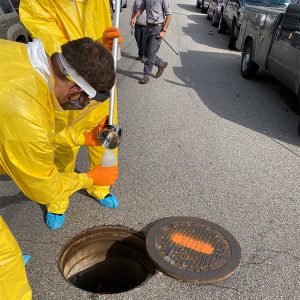Wastewater Monitoring Plan Could Keep Campus Safe From COVID-19
Story updated on September 18, 2020 to include photo.
When joint UT-Oak Ridge National Laboratory Governor’s Chair for Environmental Biotechnology Terry Hazen is called upon for his expertise in environmental microbiology, it might mean there is an international emergency.
During his career, he’s consulted about oil-eating bacteria for the Deepwater Horizon oil spill, helped officials understand the threat from exposure to deadly anthrax spores, as well as the environmental threat from a form of pneumonia called Legionnaire’s disease. That expertise in microbiology could now help institutions like UT return to a semblance of normal in the wake of the COVID-19 pandemic.
Beginning this fall, Hazen’s research team will help UT monitor the wastewater of most of the campus buildings, including all of the student dormitories, to potentially monitor 30 buildings per week. Wastewater analysis can detect whether the SARS CoV-2 virus is present, which is the organism that causes COVID-19.

“We’re just looking for that virus or its remnants in a wastewater that is coming from the building,” said Hazen, who reiterates that this type of monitoring does not have the ability to identify an individual person. “This could potentially save the university quite a bit of time and money so we don’t have to test all the students every day or even every week.”
If the team sees the virus in the samples, then they will hand them off to the other surveillance teams led by UT-ORNL Governor’s Chair Professor in Microbiology Frank Loeffler and UT-ORNL Graduate School of Genome Science and Technology Director Albrecht Von Arnim, who are doing pooled sample analysis.
Pooled sampling is a new testing approach that can significantly increase capacity by putting multiple individual samples together. From there, the surveillance team will go to each floor of a building that has positive wastewater and have a pooled sample for everybody on that floor. From that pooled sample they can tell which floor has the infected patient. The last step is to deploy contract tracing and to identify the infected individual by testing everyone on that floor.
Hazen, who chaired the committee reporting on testing options for the university, says this wastewater monitoring can be scaled up or down, depending on the need. The team intends to share the process with schools in the UT system, and the methodology could potentially be adopted by other institutions as administrators draw up plans to return to campus.